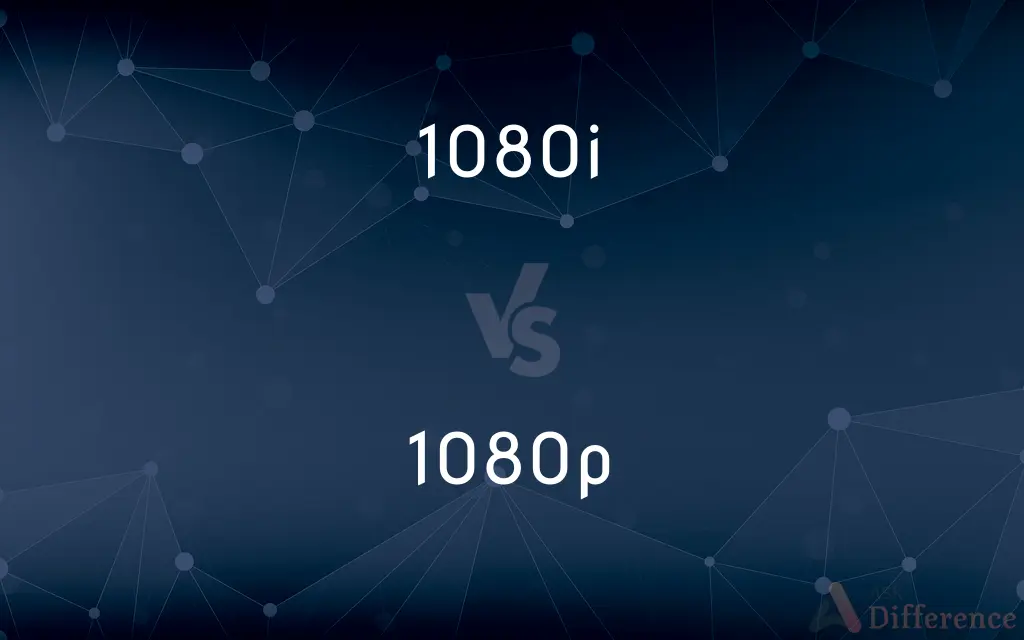1080i vs. 1080p — What's the Difference?
By Tayyaba Rehman — Published on December 5, 2023
1080i and 1080p refer to HD resolutions; 1080i uses interlaced scanning, delivering half the frame at a time, while 1080p uses progressive scanning, displaying the entire frame in one go.

Difference Between 1080i and 1080p
Table of Contents
ADVERTISEMENT
Key Differences
Both 1080i and 1080p are formats that determine how HD content is displayed on a screen. The "1080" in both terms denotes the vertical resolution, meaning there are 1,080 lines of vertical resolution. However, the way each displays images differs fundamentally.
1080i stands for 1080 interlaced lines of resolution. In this format, the screen displays every other line of the frame in one pass, and then goes back to display the alternate lines in a second pass. Essentially, it's showing half the frame at any given moment. This can sometimes result in motion artifacts, particularly in fast-moving scenes.
On the other hand, 1080p stands for 1080 progressive lines of resolution. In the 1080p format, every line of the frame is displayed at once, providing a complete picture in every refresh cycle. This tends to offer a clearer, smoother picture, especially during fast action or camera movement.
Generally speaking, 1080p is considered superior to 1080i because of its ability to deliver a full frame in every cycle. This becomes especially noticeable in scenes with a lot of movement. However, the difference might not always be easily distinguishable to the average viewer, especially on smaller screens.
Broadcasters often use 1080i because it requires less bandwidth than 1080p. Meanwhile, Blu-ray discs and gaming consoles might favor 1080p because of its quality and smoothness. When deciding between the two, one should consider the source of the content and the capabilities of the display device.
ADVERTISEMENT
Comparison Chart
Scanning Method
Interlaced (displays half the frame at a time)
Progressive (displays the entire frame at once)
Best Used For
Broadcasting
Blu-rays, gaming, streaming
Image Quality
Can show motion artifacts in fast-moving scenes
Typically clearer, especially in motion
Bandwidth Requirement
Generally less than 1080p
Requires more bandwidth
Content Availability
Common in TV broadcasts
Common in Blu-rays, gaming consoles, and some streaming
Compare with Definitions
1080i
An HD resolution using interlaced scanning.
The broadcast was in 1080i, resulting in occasional motion blur during rapid scenes.
1080p
Offers better motion clarity compared to interlaced formats.
During the car chase, the 1080p format ensured no details were missed.
1080i
Has 1,080 vertical lines of resolution displayed in an interlaced manner.
My older TV supports 1080i, displaying content with alternating lines.
1080p
An HD resolution using progressive scanning.
The movie on the Blu-ray was in 1080p, offering crystal clear quality.
1080i
Commonly used in TV broadcasting.
Most of the channels on my TV are broadcasted in 1080i format.
1080p
Commonly found in Blu-rays, streaming, and gaming.
I prefer streaming services that offer content in 1080p for a sharper image.
1080i
May result in motion artifacts in fast scenes.
The soccer match displayed some blurring because it was aired in 1080i.
1080p
Consists of 1,080 vertical lines of resolution displayed all at once.
My new screen displays everything in 1080p, making visuals vibrant and detailed.
1080i
Displays half the frame in each refresh cycle.
1080i provides a compromise between image quality and bandwidth for many broadcasters.
1080p
Displays the complete frame in each refresh cycle.
Gaming on a 1080p monitor provides smooth visuals without motion artifacts.
Common Curiosities
Can I easily notice the difference between 1080i and 1080p?
On larger screens or during fast motion, yes. On smaller screens or still scenes, differences may be minimal.
Why do broadcasters use 1080i instead of 1080p?
1080i requires less bandwidth, making it a cost-effective choice for many broadcasters.
Is there a significant price difference between 1080i and 1080p TVs?
While 1080p TVs used to be more expensive, price differences have diminished over time.
Do gaming consoles support 1080i or 1080p?
Most modern gaming consoles support 1080p for a smoother gaming experience.
Can a 1080i TV display 1080p content?
It can, but the content will be downscaled to fit the 1080i format.
Which scanning method is older, interlaced (1080i) or progressive (1080p)?
Interlaced is older and was used in early television systems.
Which offers better quality, 1080i or 1080p?
1080p typically offers better quality, especially in fast-moving scenes.
Are there resolutions higher than 1080p?
Yes, 4K and 8K are higher resolutions than 1080p.
Do DVDs support 1080i or 1080p?
DVDs are typically in a lower resolution. Blu-rays support 1080p.
Can fast-moving sports benefit from 1080p broadcasts?
Yes, 1080p can offer clearer and smoother visuals for fast-moving content like sports.
Does 1080i or 1080p have an impact on bandwidth usage for streaming?
Yes, streaming in 1080p generally requires more bandwidth than 1080i.
Can I convert 1080i content to 1080p?
Some devices can upconvert 1080i to 1080p, but the true quality of 1080p content might not be achieved.
Is 1080p the same as Full HD?
Yes, 1080p is often referred to as Full HD.
Is there a difference in color accuracy between 1080i and 1080p?
Color accuracy is more about the display technology and calibration than the resolution format.
If I have a 1080p source, should I avoid 1080i displays?
While 1080p sources are best viewed on 1080p displays, they can still look good on 1080i displays with some quality loss.
Share Your Discovery

Previous Comparison
M.Phil. vs. Ph.D.
Next Comparison
Android Marshmallow 6.0 vs. Android Marshmallow 6.0.1Author Spotlight
Written by
Tayyaba RehmanTayyaba Rehman is a distinguished writer, currently serving as a primary contributor to askdifference.com. As a researcher in semantics and etymology, Tayyaba's passion for the complexity of languages and their distinctions has found a perfect home on the platform. Tayyaba delves into the intricacies of language, distinguishing between commonly confused words and phrases, thereby providing clarity for readers worldwide.
















































